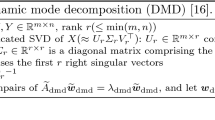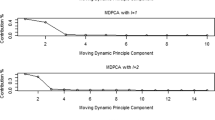Abstract
Time series usually consist of an underlying trend and the irregularities. Therefore, the underlying trend extraction plays an important role in the analysis of the time series. This paper proposes a method which combines the ensemble intrinsic timescale decomposition (EITD) algorithm and the matching pursuit (MP) approach for performing the underlying trend extraction. In order to extract the underlying trend, the EITD algorithm is applied to obtain a set of components. Then, the first component which contains most of the noise is removed. Next, some appropriate components are selected by the MP approach. In particular, the total number of components that composites of the underlying trend is minimized. To guarantee that the underlying trend tracks the signal, it is required to impose a constraint on the maximum absolute error between the underlying trend and the denoised signal. As the selection of the EITD components is binary, this component selection problem is formulated as an \( L_{0} \)-norm binary programming problem subject to the specification on the maximum absolute error between the denoised signal and the underlying trend. This optimization problem is further solved by the MP approach. Finally, the underlying trend is constructed. Compared with the conventional empirical mode decomposition algorithm and the ensemble empirical mode decomposition algorithm, our proposed approach could extract a better underlying trend for some random time series.











Similar content being viewed by others
References
C. Chatfield, The Analysis of Time Series: An Introduction (Chapman and Hall, London, 1996)
P. Flandrin, G. R, P. Goncalves, Empirical mode decomposition as a filter bank. IEEE Signal Process. Lett. 11(2), 112–114 (2004)
M.G. Frei, I. Osorio, Intrinsic time-scale decomposition: time-frequency-energy analysis and real-time filtering of non-stationary signals. Procee. R. Soc. Math. Phys. Eng. Sci. 463(2078), 321–342 (2007)
J. Gu, P. Lin, B.W.-K. Ling, C. Yang, P. Feng, Grouping and selecting singular spectral analysis components for denoising based on empirical mode decomposition via integer quadratic programming. IET Signal Process. 12(5), 599–604 (2018)
T.Y. Hou, Z. Shi, Sparse time-frequency representation of nonlinear and nonstationary data. Sci. China Math. 56(12), 2489–2506 (2013)
A. Hu, X. Yan, L. Xiang, A new wind turbine fault diagnosis method based on ensemble intrinsic time-scale decomposition and WPT-fractal dimension. Renew. Energy 83, 767–778 (2015)
N.E. Huang, Z. Shen, S.R. Long, M.C. Wu, H.H. Shih, Q. Zheng, N.-C. Yen, C. Tung, H.H. Liu, The empirical mode decomposition and the Hilbert spectrum for nonlinear and nonstationary time series analysis. Proc. R. Soc. Math. Phys. Eng. Sci. 454(1971), 903–995 (1998)
Y. Li, L. Xie, B.W.-K. Ling, J. Cao, Q. Dai, Efficient method for finding globally optimal solution of problem with weighted Lp norm and L2 norm objective function. IET Signal Process. 10(4), 366–375 (2016)
S.G. Mallat, Z. Zhang, Matching pursuits with time-frequency dictionaries. IEEE Trans. Signal Process. 41(12), 3397–3415 (1993)
D. Needell, J.A. Tropp, CoSaMP: iterative signal recovery from incomplete and inaccurate samples. Appl. Comput. Harmonic Anal. 26(3), 3.1–3.21 (2009)
Y.C. Pati, R. Rezaiifar, P.S. Krishnaprasad, Orthogonal matching pursuit: recursive function approximation with applications to wavelet decomposition, in Proceedings of 27th Asilomar Conference on Signals, Systems and Computers, vol. 1, pp. 40–44
M. Qi, P.G. Zhang, Trend time-series modeling and forecasting with neural networks. IEEE Trans. Neural Netw. 19(5), 808–816 (2008)
J.M. Restrepo, S.C. Venkataramani, D. Comeau, H. Flaschka, Defining a trend for a time series which makes use of the intrinsic time-scale decomposition. New J. Phys. 16(8) (2014). https://doi.org/10.1088/1367-2630/16/8/085004
P. Tommaso, Trend-cycle decompositions with correlated components. Econom Rev 25(1), 61–84 (2006)
J.A. Tropp, A.C. Gilbert, Signal recovery from random measurements via orthogonal matching pursuit. IEEE Trans. Inf. Theory 53(12), 4655–4666 (2007)
M.S. Ullah, M.H. Chowdhury, Analytical models of high-speed RLC interconnect delay for complex and real poles. IEEE Trans. Very Large Scale Integ. (VLSI) Syst. 25(6), 1831–1841 (2017)
Z. Wu, N.E. Huang, Ensemble empirical mode decomposition: a noise assisted data analysis method. World Sci. Adv. Adapt. Data Anal. 1(1), 1–41 (2009)
Z. Wu, N.E. Huang, S.R. Long, C.-K. Peng, On the trend, detrending, and variability of nonlinear and nonstationary time series. Proc. Natl. Acad. Sci. U.S.A. 104(38), 14889–14894 (2007)
X. Xie, D. Yue, H. Songliu, Fault estimation observer design of discrete-time nonlinear systems via a joint real-time scheduling law. IEEE Trans. Syst. Man Cybern. Syst. 47(7), 1451–1463 (2017)
X. Xie, D. Yue, H. Zhang, Y. Xue, Fault estimation observer design for discrete-time Takagi-Sugeno fuzzy systems based on homogenous polynomially parameter-dependent Lyapunov functions. IEEE Trans. Cybern. 47(9), 2504–2513 (2017)
Z. Yang, B.W.K. Ling, C. Bingham, Joint empirical mode decomposition and sparse binary programming for underlying trend extraction. IEEE Trans. Instrum. Meas. 62(10), 2673–2682 (2013)
J. Zhang, Y. Liu, Application of complete ensemble intrinsic time-scale decomposition and least-square SVM optimized using hybrid DE and PSO to fault diagnosis of diesel engines. Front. Inf. Technol. Electron. Eng. 18(2), 272–286 (2017)
Acknowledgements
This paper is supported partly by the National Nature Science Foundation of China (Nos. U1701266, 61372173 and 61671163), the Guangdong Higher Education Engineering Technology Research Center for Big Data on Manufacturing Knowledge Patent (No. 501130144), the Natural Science Foundation of Guangdong Province, China (No. 2014A030310346), and the Science and Technology Planning Project of Guangdong Province, China (No. 2015A030401090).
Author information
Authors and Affiliations
Corresponding author
Additional information
Publisher's Note
Springer Nature remains neutral with regard to jurisdictional claims in published maps and institutional affiliations.
Rights and permissions
About this article
Cite this article
Wang, X., Ling, B.WK. Underlying Trend Extraction via Joint Ensemble Intrinsic Timescale Decomposition Algorithm and Matching Pursuit Approach. Circuits Syst Signal Process 38, 4621–4639 (2019). https://doi.org/10.1007/s00034-019-01069-2
Received:
Revised:
Accepted:
Published:
Issue Date:
DOI: https://doi.org/10.1007/s00034-019-01069-2




